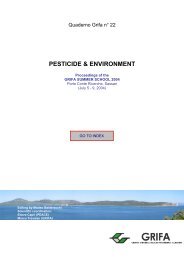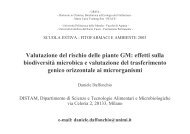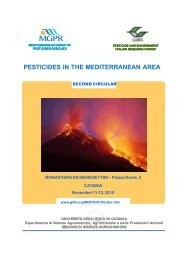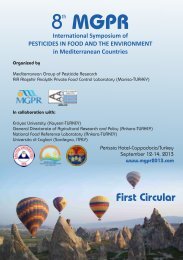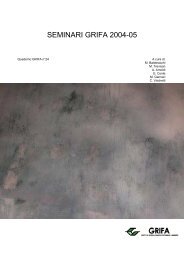International Congress BIOLOGICAL PRODUCTS - Gruppo di ...
International Congress BIOLOGICAL PRODUCTS - Gruppo di ...
International Congress BIOLOGICAL PRODUCTS - Gruppo di ...
Create successful ePaper yourself
Turn your PDF publications into a flip-book with our unique Google optimized e-Paper software.
5<br />
INSETTICIDI D’ORIGINE VEGETALE E ACARI<br />
Castagnoli M., Liguori M., Nannelli R., Simoni S.<br />
Sezione <strong>di</strong> Acarologia, Istituto Sperimentale per la Zoologia Agraria. Firenze<br />
Different formulations of extracts of neem, derris, equisetum, ryania, wormwood, garlic, chrysanthemum, and<br />
bitter wood were tested on the phytophagous mite Tetranychus urticae, the phytoseiid Neoseiulus californicus, the<br />
stored food mite Lepidoglyphus destructor to evaluate their <strong>di</strong>fferent toxicity on eggs and females and the effects on the<br />
female fecun<strong>di</strong>ty.<br />
On the whole, these botanical pesticides were more effective on eggs than on motile stages. The highest<br />
toxicity was registered on N. californicus.<br />
The extracts based on low concentrations of aza<strong>di</strong>rachtina and neem oil were the most toxic for the females and<br />
the eggs of the tetranychid and <strong>di</strong>d not significantly affect the survival and fecun<strong>di</strong>ty of the phytoseiid. Derris and<br />
wormwood extracts were the most effective on the stored food mite.<br />
KEY WORDS: Tetranychus urticae, Neoseiulus californicus, Lepidoglyphus destructor, neem, derris, ryania, wormwood,<br />
chrysanthemum, bitter wood.<br />
INTRODUZIONE<br />
Negli ultimi anni una maggiore sensibilità verso le conseguenze negative per l’ambiente determinate dall’uso<br />
<strong>di</strong> molti pestici<strong>di</strong> <strong>di</strong> sintesi ha determinato anche nel nostro Paese una crescita <strong>di</strong> interesse nei confronti dei prodotti<br />
d’origine vegetale ritenuti più facilmente degradabili. L'uso <strong>di</strong> questi prodotti commercializzati sia come insettici<strong>di</strong> o<br />
più genericamente come biostimolanti e coa<strong>di</strong>uvanti ad azione limitatrice nei confronti <strong>di</strong> artropo<strong>di</strong> nocivi si è<br />
particolarmente affermato in agricoltura biologica. Nell'ottica <strong>di</strong> una valutazione complessiva dei loro effetti, si rende<br />
quin<strong>di</strong> sempre più necessaria la verifica anche sulle specie non target.<br />
L’efficacia <strong>di</strong> sostanze naturali come rotenone, piretro e quassia è nota da tempo, più recente è l’interesse per i<br />
derivati <strong>di</strong> Aza<strong>di</strong>racta in<strong>di</strong>ca (A. Juss) ritenuti in grado <strong>di</strong> esplicare azione tossica, repellente, fagodeterrente e inibitrice<br />
della crescita su moltissime specie <strong>di</strong> artropo<strong>di</strong> (SCHMUTTERER, 1990). Per quanto riguarda gli acari le conoscenze sono<br />
molto limitate e, se poche sono le ricerche de<strong>di</strong>cate all'attività biologica <strong>di</strong> estratti <strong>di</strong> neem (MANSOUR et al.,1987,1997;<br />
SUNDARAN & SLOANE, 1995; SPOLLEN & ISMAN, 1996; MOMEN et al., 1997; PAPAIOANNOU-SOULIOTIS et al., 1997;<br />
TSOLAKIS et al., 1997), ancora meno sono quelle che prendono in esame altri principi <strong>di</strong> origine naturale (PERRUCCI,<br />
1995; GULATI & MATHUR, 1995; CASTAGNOLI et al., 2002).<br />
Nell' ambito <strong>di</strong> un più vasto programma <strong>di</strong> indagini, l’efficacia <strong>di</strong> alcuni principi attivi <strong>di</strong> origine vegetale è<br />
stata saggiata su tre delle più comuni specie <strong>di</strong> acari: Tetranychus urticae Koch, Neoseiulus californicus (McGregor) e<br />
Lepidoglyphus destructor (Schrank) (CASTAGNOLI et al., 2000; NANNELLI & SIMONI, 2001). Il primo è un fitofago<br />
estremamente polifago e in grado <strong>di</strong> causare seri danni su un’ampia gamma <strong>di</strong> colture, il secondo è un fitoseide<br />
predatore frequentemente associato al tetranichide e in grado <strong>di</strong> contrastarne le pullulazioni, mentre il terzo è un acaro<br />
astigmata che colonizza le più <strong>di</strong>sparate derrate alimentari immagazzinate che vanno dai cereali ai salumi e ai formaggi.<br />
MATERIALI E METODI<br />
I prodotti saggiati e le relative <strong>di</strong>luizioni, che corrispondono alle dosi massime consigliate dai produttori, sono<br />
elencati nelle tabelle 1-3. In laboratorio sono stati valutati gli effetti sulla schiusura delle uova e sulla sopravvivenza<br />
delle femmine su un totale <strong>di</strong> 80 esemplari o uova per prodotto. Per il fitofago e il predatore è stata presa in<br />
considerazione anche l’incidenza sulla fecon<strong>di</strong>tà.<br />
I meto<strong>di</strong> usati erano <strong>di</strong>versificati a seconda dello sta<strong>di</strong>o e delle caratteristiche della specie: “<strong>di</strong>p method” (HELLE &<br />
OVERMEER, 1985) e “microimmersion bioassay” (mo<strong>di</strong>ficato da DENNEHY et al., 1993) sono stati usati rispettivamente<br />
per tutte le uova e per le femmine del fitofago e del predatore, mentre per le femmine dell’astigmata è stato usato il<br />
metodo "impregnated filter paper bioassay" secondo THIND & MUGGLETON (1998).<br />
I risultati sono stati espressi come percentuale <strong>di</strong> tossicità globale (E), combinando mortalità e fecon<strong>di</strong>tà delle<br />
femmine del trattato e del non trattato (OVERMEER & VAN ZOON, 1982) o come mortalità <strong>di</strong> ABBOTT (1925), tenendo<br />
conto dell’eventuale mortalità naturale registrata nel testimone.<br />
PDF creato con FinePrint pdfFactory versione <strong>di</strong>mostrativa http://www.secom.re.it/fineprint<br />
53



